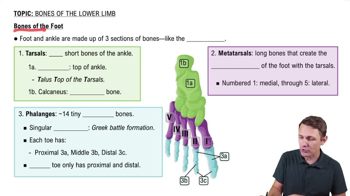Mark the following statements as true or false. If a statement is false, correct it to make a true statement.
e. The pelvic brim is the boundary between the greater and lesser pelvis.
 Verified step by step guidance
Verified step by step guidance



Mark the following statements as true or false. If a statement is false, correct it to make a true statement.
e. The pelvic brim is the boundary between the greater and lesser pelvis.
The most lateral projection of the proximal epiphysis of the femur is the:
a. lesser trochanter
b. gluteal tuberosity
c.greater trochanter
d.femoral neck.
Fill in the blanks: The bones of the leg are the medial_____and the lateral______. The sesamoid bone that articulates with the distal femur is the______.
The arch(es) of the foot are the:
a. transverse arch.
b. medial longitudinal arch.
c. lateral longitudinal arch.
d.Both a and b are correct.
e.All of the above are correct.
Mrs. Dent presents to the clinic with back pain. During the exam, you notice that she has severe kyphosis, and you suspect a vertebral fracture. What specific part of her vertebra is likely to be fractured, considering her deformity? Explain.
You arrive on the scene where a person without a pulse was found. Someone on the scene performed CPR, but the individual unfortunately could not be revived. On postmortem examination, it is discovered that several ribs and the xiphoid process were fractured. What likely caused these fractures?